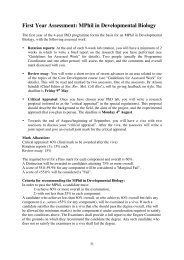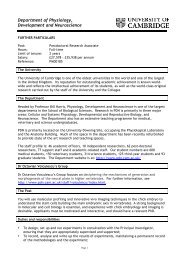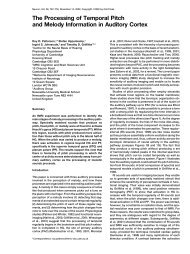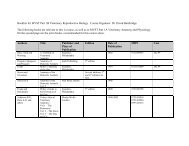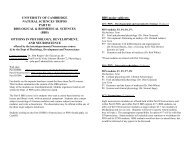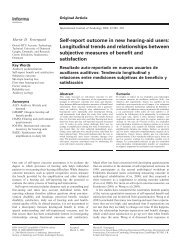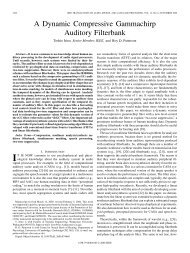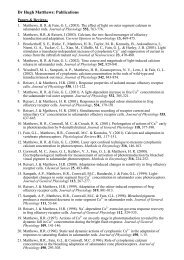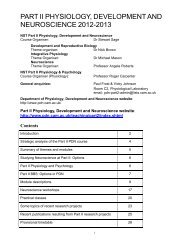FRIDAY MORNING, 20 MAY 2005 REGENCY E, 8:30 A.M. TO 12:00 ...
FRIDAY MORNING, 20 MAY 2005 REGENCY E, 8:30 A.M. TO 12:00 ...
FRIDAY MORNING, 20 MAY 2005 REGENCY E, 8:30 A.M. TO 12:00 ...
Create successful ePaper yourself
Turn your PDF publications into a flip-book with our unique Google optimized e-Paper software.
cess by which speakers alter their speech production in order to compensate<br />
for perturbations of normal auditory feedback. Specifically, the first<br />
formant frequency (F1) was shifted in the auditory feedback heard by<br />
naive adult subjects as they produced vowels in single syllable words.<br />
Results presented previously indicate that the subjects demonstrate compensatory<br />
formant shifts in their speech. The current study investigates the<br />
relationship between compensatory adaptation and speaker perceptual acuity.<br />
Subjects from the SA study were tested for their ability to discriminate<br />
vowel tokens differing in F1 frequency. Preliminary results indicate that<br />
subjects with greater perceptual acuity also demonstrated greater ability to<br />
adapt, with a significant cross-subject correlation (p less than 0.05. The<br />
relation between these experimental findings and DIVA, a neurocomputational<br />
model of speech motor planning by the brain, will also be discussed.<br />
Work supported by NIDCD Grant R01-DC01925.<br />
5pSC10. Glottal-wave and vocal-tract-area-function estimations from<br />
vowel sounds based on realistic assumptions and models. Huiqun<br />
Deng, Rabab K. Ward, Micheal P. Beddoes Elec. and Comput. Eng.<br />
Dept., Univ. of British Columbia, Canada, Murray Hodgson, and Bryan<br />
Gick Univ. of British Columbia, Canada<br />
Estimating glottal waves by inverse filtering vowel sounds and deriving<br />
vocal-tract area functions VTAFs from vocal-tract filter VTF estimates<br />
require that VTF models be realistic and that VTF estimates contain<br />
no effects of open glottises and glottal waves. In this study, VTFs are<br />
modeled to have lip reflection coefficients with low-pass frequency responses;<br />
to minimize the effects of open glottises and glottal waves on the<br />
estimates, VTFs are estimated from sustained vowel sounds over closed<br />
glottal phases, assuming that the glottal waves are periodically stationary<br />
random processes. Since incomplete glottal closures are common, VTF<br />
estimates may contain the effects of glottal loss. To eliminate the effects of<br />
glottal loss in the VTF estimates, lip-opening areas must be known. Theoretically,<br />
estimates of glottal waves and VTAFs corresponding to large-lipopening<br />
vowel sounds are less affected by the glottal loss than those<br />
corresponding to small-lip-opening vowel sounds. The VTAFs and glottal<br />
waves estimated from vowel sounds produced by several subjects are presented.<br />
The normalized VTAFs estimated from large-lip-opening sounds<br />
are similar to that measured from an unknown subjects magnetic resonance<br />
image. Over closed glottal phases, the glottal waves are non-zero.<br />
They increase during vocal-fold colliding, and decrease or even increase<br />
during vocal-fold parting.<br />
5pSC11. Cross-modal perception of vowels, stops, and approximants<br />
using reduced-formant stimuli. Philip Rubin Haskins Labs., 270<br />
Crown St., New Haven, CT 06511-6<strong>20</strong>4 and Yale Univ., School of<br />
Medicine, New Haven, CT, rubin@haskins.yale.edu, Catherine Best<br />
Haskins Labs., New Haven, CT 06511-6<strong>20</strong>4, Gordon Ramsay, Stephen<br />
Frost, and Bruno Repp Haskins Labs., New Haven, CT 06511-6<strong>20</strong>4<br />
This paper explores the relationship between audio and video representations<br />
of speech, by examining how information in particular formants<br />
is complemented by facial information, for different classes of speech<br />
sounds. Specifically, we investigate whether acoustic information removed<br />
by deleting formant combinations that usually signal contrasts between<br />
vowels (F1,F2), stops (F2) and approximants (F3) can be replaced by<br />
optical information derived from the talking face. Simultaneous audio and<br />
video recordings were made of speakers uttering CVC nonsense syllables<br />
constructed from vowels, stops, and approximants exhibiting varying degrees<br />
of facial motion and varying dependence on individual formant cues.<br />
Synthetic stimuli were then resynthesized from combinations of one, two,<br />
and three formants using a parallel formant synthesizer. Subjects performed<br />
an auditory identification task with stimuli presented in an audioonly<br />
condition, followed by a separate block of stimuli presented in an<br />
audio-visual condition. Source effects were examined using an inversefiltered<br />
source and a synthetic source with constant source characteristics.<br />
There were no differences between source conditions, but differences were<br />
obtained between the audio and audiovideo conditions that reflect the<br />
relationship between facial and formant dynamics. These results complement<br />
recent research on perception of reduced video information and complete<br />
audio information L. Lachs and D. B. Pisoni, J. Acoust. Soc. Am.<br />
116, 507–518 <strong>20</strong>04. Work supported by NIH.<br />
5pSC<strong>12</strong>. Analysis of vowel and speaker dependencies of source<br />
harmonic magnitudes in consonant-vowel utterances. Markus Iseli,<br />
Yen-Liang Shue, and Abeer Alwan UCLA, 405 Hilgard Ave., Los<br />
Angeles, CA 9<strong>00</strong>95, iseli@ee.ucla.edu<br />
It is assumed that voice quality characteristics are mainly manifested<br />
in the glottal excitation signal. As Holmberg et al., J. Speech Hear. Res.<br />
38, <strong>12</strong><strong>12</strong>–<strong>12</strong>23 1995 showed, there is a correlation between lowfrequency<br />
harmonic magnitudes of the glottal source spectrum and voice<br />
quality parameters. In this study, we assess the influence of vowel and<br />
speaker differences on the difference between the first and the second<br />
harmonic magnitudes, H 1 H 2 . The improved harmonics correction formula<br />
introduced in Iseli et al., Proceedings of ICASSP, Vol. 1 <strong>20</strong>04, pp.<br />
669–672 is used to estimate source harmonic magnitudes. H 1 H 2 is<br />
estimated for consonant-vowel utterances where the vowel is one of the<br />
three vowels /a,i,u/ and the consonant is one of the six plosives in American<br />
English /b,p,d,t,g,k/. Several repetitions of each of the utterances,<br />
spoken by two male and two female talkers, are analyzed. Other measurements,<br />
such as fundamental frequency, F 0 , and energy are estimated pitch<br />
synchronously. Results are compared to current literature findings. Work<br />
supported by NSF.<br />
5pSC13. Pharynx depth and tongue height in relationship to intrinsic<br />
F0 of vowels. D. H. Whalen, Leonardo Oliveira, and Bryan Gick<br />
Haskins Labs, 270 Crown St., New Haven, CT 06511,<br />
whalenAEA@haskins.yale.edu<br />
Intrinsic F0 (IF0) is the tendency for high vowels to have higher F0s<br />
than low vowels. It is universal and apparently automatic, but the exact<br />
mechanism is still unclear. Here, ultrasound measurements of the tongue<br />
were used to determine whether vowel height is the best predictor of IF0.<br />
Ten native speakers of English spoke keywords for the eleven nondiphthongal<br />
vowels while the lips, jaw, and tongue were imaged with the<br />
HOCUS ultrasound/Optotrak system D. H. Whalen et al., J. Sp. Lang.<br />
Hear. Res. in press, which tracks the head and lips with optical markers<br />
while the tongue is imaged with ultrasound. The tongue edge can be extracted<br />
and rotated relative to the head, indicating changes in tongue<br />
height and pharyngeal depth. Preliminary analysis indicates that IF0 is<br />
better correlated with the most anterior point on the tongue root indicating<br />
pharyngeal depth than with the highest point on the tongue. It thus<br />
seems likely that the shape of the pharynx is more of a determinant than<br />
tongue height for IF0. Because pharynx depth and vowel height covary in<br />
most languages including English, the earlier description is somewhat<br />
accurate; IF0 may be more accurately described as correlated to the<br />
tongue root.<br />
5pSC14. Acoustically-guided articulation patterns for vowel<br />
production. Brad Story Dept. of Speech, Lang., and Hearing Sci.,<br />
Univ. of Arizona, P.O. Box 21<strong>00</strong>71, Tucson, AZ 85721, bstory@<br />
u.arizona.edu<br />
The purpose of this study was to investigate the link between the vocal<br />
tract deformation patterns obtained from statistical analyses of articulatory<br />
data i.e., measured area functions and the acoustic properties of a realistic<br />
neutral vocal tract shape. The starting point was a previously reported<br />
statistical analysis i.e., PCA of a speaker-specific set of measured vowel<br />
area functions. It resulted in a mean area function, and two basis functions<br />
that perturb the vocal tract into vowel-like shapes. In the present study,<br />
acoustic sensitivity functions were calculated for the same mean area function.<br />
Then, four separate sum and difference combinations of the sensitivity<br />
functions were used directly to perturb the mean area function. The<br />
2619 J. Acoust. Soc. Am., Vol. 117, No. 4, Pt. 2, April <strong>20</strong>05 149th Meeting: Acoustical Society of America 2619<br />
5p FRI. PM



